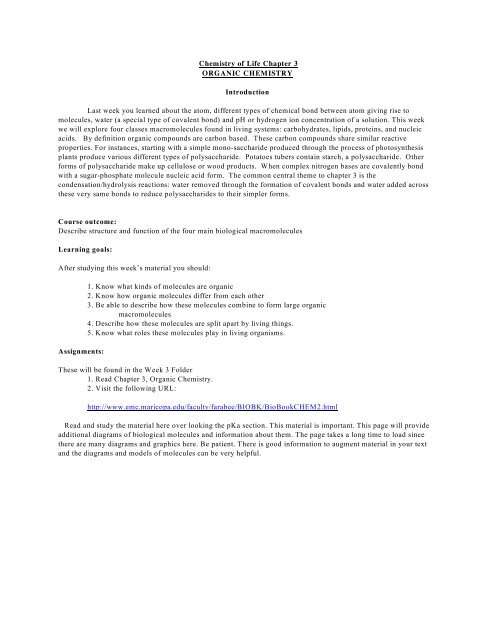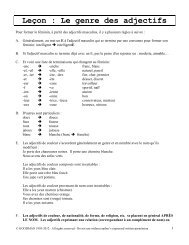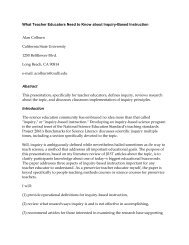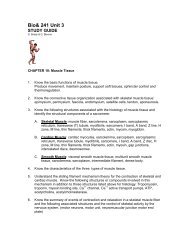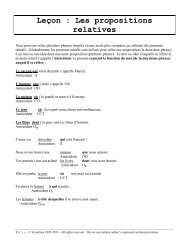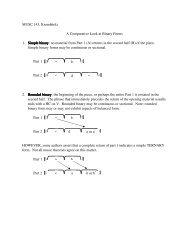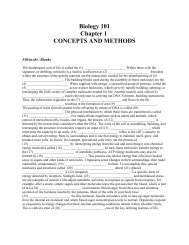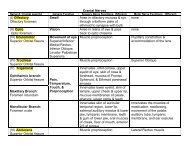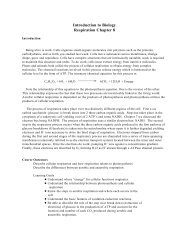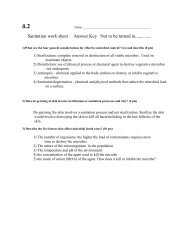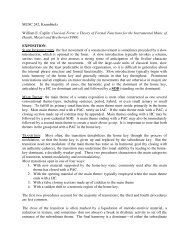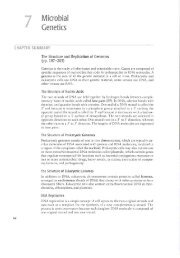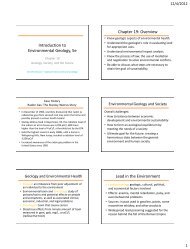Chemistry of Life Chapter 3 ORGANIC CHEMISTRY Introduction ...
Chemistry of Life Chapter 3 ORGANIC CHEMISTRY Introduction ...
Chemistry of Life Chapter 3 ORGANIC CHEMISTRY Introduction ...
You also want an ePaper? Increase the reach of your titles
YUMPU automatically turns print PDFs into web optimized ePapers that Google loves.
<strong>Chemistry</strong> <strong>of</strong> <strong>Life</strong> <strong>Chapter</strong> 3<strong>ORGANIC</strong> <strong>CHEMISTRY</strong><strong>Introduction</strong>Last week you learned about the atom, different types <strong>of</strong> chemical bond between atom giving rise tomolecules, water (a special type <strong>of</strong> covalent bond) and pH or hydrogen ion concentration <strong>of</strong> a solution. This weekwe will explore four classes macromolecules found in living systems: carbohydrates, lipids, proteins, and nucleicacids. By definition organic compounds are carbon based. These carbon compounds share similar reactiveproperties. For instances, starting with a simple mono-saccharide produced through the process <strong>of</strong> photosynthesisplants produce various different types <strong>of</strong> polysaccharide. Potatoes tubers contain starch, a polysaccharide. Otherforms <strong>of</strong> polysaccharide make up cellulose or wood products. When complex nitrogen bases are covalently bondwith a sugar-phosphate molecule nucleic acid form. The common central theme to chapter 3 is thecondensation/hydrolysis reactions: water removed through the formation <strong>of</strong> covalent bonds and water added acrossthese very same bonds to reduce polysaccharides to their simpler forms.Course outcome:Describe structure and function <strong>of</strong> the four main biological macromoleculesLearning goals:After studying this week’s material you should:Assignments:1. Know what kinds <strong>of</strong> molecules are organic2. Know how organic molecules differ from each other3. Be able to describe how these molecules combine to form large organicmacromolecules4. Describe how these molecules are split apart by living things.5. Know what roles these molecules play in living organisms.These will be found in the Week 3 Folder1. Read <strong>Chapter</strong> 3, Organic <strong>Chemistry</strong>.2. Visit the following URL:http://www.emc.maricopa.edu/faculty/farabee/BIOBK/BioBookCHEM2.htmlRead and study the material here over looking the pKa section. This material is important. This page will provideadditional diagrams <strong>of</strong> biological molecules and information about them. The page takes a long time to load sincethere are many diagrams and graphics here. Be patient. There is good information to augment material in your textand the diagrams and models <strong>of</strong> molecules can be very helpful.
2I. INTRODUCTIONA. The Molecules <strong>of</strong> a living system1. Carbohydrates, lipids, proteins, and nucleic acidsall have CARBON in common2. Carbon needs 4 more electrons(X’s in figure are electrons unpaired electrons)MethaneEthaneGlucose1. Many structural configurations possibleBranchedRingb. Carbon compounds are generally referredas <strong>ORGANIC</strong> COMPOUNDShttp://www.tvdsb.on.ca/westmin/science/sbioac/biochem/bioacu1.htmII. PROPERTIES OF <strong>ORGANIC</strong> COMPOUNDSA. Organic compounds consist <strong>of</strong> carbon and one or more additional elements, covalently bonded to oneanother
3B. Carbon-to-carbon bonds and the stability to organic compounds-Carbon can share e with as many as 4 other atoms to form organic molecules<strong>of</strong> several configurationC. Carbon-to-carbon bonds and these shapes can vary1. Single bonded carbon atom can freely rotate2. A double bond is restricted in rotation3. Interactions between carbon atoms give rise to a 3-d shape and functionD. Hydrocarbons and functional groups1. Only hydrogen atoms are attached to carbon backbone2. FUNCTIONAL GROUPS: are atoms or groups <strong>of</strong> atoms covalentlybonded to a carbon backbone;III. HOW CELLS USE <strong>ORGANIC</strong> COMPOUNDSA. Different classes <strong>of</strong> carbon reactionsa) Properties: solubility and chemical reactivity1. Enzymes are a special class <strong>of</strong> proteins that mediated various biological type <strong>of</strong>reactions (we will not have to know all <strong>of</strong> these reactions... except for a. & b.)a. A condensation reaction: Water removed between bonds <strong>of</strong> simple sugar tomake a complex sugar(2 monosaccharides) --------> disaccharide + H2OGlucose + Fructose --------> Sucrose + H2Ob. Hydrolysis reaction is the reverse: Water added across bondsEx.: Protein + H2O ---------> Protein + amino acidshttp://www.tvdsb.on.ca/westmin/science/sbioac/biochem/condense.htmIV. THE SMALL CARBOHYDRATESA. Monosaccharides -- The simple sugarsGlucose Fructose GalactoseB. Oligosaccharide: Two or more units <strong>of</strong> a simple sugar1) Disaccharides: Sucrose, Maltose, Lactose, ect....C. Purpose: Carbohydrates provide quick and long term energy products, act in the capacity
4<strong>of</strong> structural support materials, and provide carbon frame work skeletal structures.V. COMPLEX CARBOHYDRATES: THE POLYSACCHARIDEA. Polysaccharide: (meaning many)Ex.: Large amounts <strong>of</strong> similar repeating subunits <strong>of</strong> simple sugars (Starch)B. Starch: Glucose with linking in an -1,4 configurationC. Cellulose: Glucose with various cross linking in -1,4 configurationD. Glycogen: mammalian storage <strong>of</strong> glucose units...Storage in animal’s liver.E. Chitin: nitrogen sugar compound exoskeleton <strong>of</strong> insects and crabshttp://www.mansfield.ohio-state.edu/~sabedon/biol4020.htmhttp://www.mansfield.ohio-state.edu/~sabedon/biol1025.htmVI. LIPIDSA. LipidsB. Fatty Acids1. A fatty acid is long chain <strong>of</strong> mostly carbon and hydrogen atoms with a-COOH group at one end2. When they are part <strong>of</strong> complex lipids, the fatty acids are like long,flexible tails.C. Neutrals fats (Triglycerides)D. phospholipidsFatty acid glycerol componentsPhosphate nitrogen head.... Used in membrane stabilityE. Waxes: Bee’s waxF. Sterols and their derivativesG. Purpose: Lipids pack 2 times more energy value than carbohydrates providing structural membranecomponents and water pro<strong>of</strong> coatings.http://www.indstate.edu/thcme/mwking/lipids.html#roleVII. PROTEINS
6Special note: You should sight recognize a molecule illustration <strong>of</strong>:1. ATP2. Mono- and Di-saccharide3. Triglyceride4. Sterol5. Amino Acid6. Phospholidhttp://www.gen.umn.edu/faculty_staff/jensen/1135/webanatomy/wa_cell_chem/wa2_BioChem1.htmhttp://www.emc.maricopa.edu/faculty/farabee/BIOBK/BioBookCHEM1.htmlhttp://www.emc.maricopa.edu/faculty/farabee/BIOBK/BioBookCHEM2.html
Biology 101 <strong>Chapter</strong> 3Name __________________In the table below, enter the name <strong>of</strong> the carbohydrate described by its carbohydrate class and functions.Carbohydrate Carbohydrate Class FunctionMost plentiful sugar in nature; transport form <strong>of</strong>carbohydrates in plants table sugar formed from glucose andfructoseFive-carbon sugar occurring in DNAMain energy source form most organism; precursor <strong>of</strong> manyorganic organisms. Serve as building blocks for largercarbohydratesStructural materials for plant cell walls; formed from glucosechainsFive-carbon sugar occurring in RNASugar present in milk; formed from glucose and galactoseA branched starch that invites rapid mobilization <strong>of</strong> glucose;formed from glucose chains.Main structural material in some external skeletons and otherhard body parts <strong>of</strong> some animals and fungiAnimal starch; stored especially in liver and muscle tissue;formed from glucose chainsLong-term glucose storage form in plants; a starch formedfrom glucose chains.Choose the most appropriate answer for each item. Some letters may be used more than once.1. _____ atherosclerotic plaques A. Fatty acid2. _____ richest source <strong>of</strong> body energy B. Neutral fats3._____ Honeycomb materialC. Phospholipids4. _____ Cholesterol D. Waxes5. _____ Saturated tails E. Sterols6. _____ Butter and lard7._____ Lack fatty acid tails8. _____ main cell membrane component9. _____ All possess a rigid backbone <strong>of</strong> four fused carbon rings10._____ Plant cuticles11. _____ Triglycerides12._____ Precursors <strong>of</strong> testosterone, estrogen, and bile salts13. _____ Unsaturated tails14. _____ Vegetable oil15. _____ Vertebrate insulation16. _____ Furnishes lubrication for skin and feathers
Choose the most appropriate answer for each term.17. _____ amino acid A. a coiled or extended pattern <strong>of</strong> protein structure caused byregular intervals <strong>of</strong> H bonds18. _____ peptide bond B. Three or more amino acids joined in a linear chain19. _____ polypeptide chain C. Proteins with linear or branched oligosaccharides covalently20._____ primary structure bonded to them; found on animal cell surfaces, in cellsecretion or on blood proteins21. _____ protein D. Folding <strong>of</strong> a protein through interactions among R groups <strong>of</strong> apolypeptide chain22. _____ secondary structure E. Form when freely circulating blood proteins encounter andcombine with cholesterol, or phospholipids23. _____ tertiary structure F. The type <strong>of</strong> covalent bond linking one amino acid to anotherG. An example is hemoglobin which contains four globular24. _____ dipeptide proteins25. _____ quaternary structure H. Breaking weak bonds in large molecules (such as protein) tochange its shape so it no longer functions26. _____ lipoproteins I. Formed when two amino acids join togetherJ. Lowest level <strong>of</strong> protein structure; has a linear, unique sequence27. _____ glycoproteins <strong>of</strong> amino acids an acid group, hydrogen atom, and R groupK. A small organic compound having an amino group, and acid28. _____ denaturation group, a Hydrogen atom, and R groupL. The most divers <strong>of</strong> all the large biological molecules;constructed from pools <strong>of</strong> only twenty kinds <strong>of</strong> amino acidsChoose the most appropriate answer for each term30. _____adenosine triphosphate31. _____ RNA32. _____ DNA+33. _____ NAD and FAD34._____ cAMPA. Single nucleotide strand; function in processes bywhich genetic instructions are used to build proteinsB. ATP, a cellular energy carrierC. Nucleotide chemical messengerD. Single nucleotide units; coenzymes; transport hydrogen ionsand their associated electrons from one cell reaction site toanotherE. Double nucleotide strand; encodes genetic instructions withnucleotide sequences.
Complete the tale below by entering the correct name <strong>of</strong> the major cellular organic compounds suggested in the ‘types’ column(choose from carbohydrates, lipids, proteins, and nucleic acids)Cellular Organic CompoundsTypesa. Phospholipidsb. Antibodiesc. Enzymesd. Genese. Glycogen, starch, cellulose, and chitinf. Glyceridesg. Saturated and unsaturated fatsh. Coenzymesi. Sterols, oils and waxesj. Glucose and sucrose
Self-Quiz____1. Amino acids are linked by _____ bonds t<strong>of</strong>orm the primary structure <strong>of</strong> a protein.a. Disulfide b. hydrogenc. ionic d. peptide____2. Proteins __________a. are weapons against disease-causing bacteriaand other invaders.b. are composed <strong>of</strong> nucleotides subunitsc. translate protein-building instructions intoactual protein structuresd. lack diversity <strong>of</strong> structure and function____3. Lipids ____a. include fats that are broken down into onefatty acid molecule and three glycerolmoleculesb. are composed <strong>of</strong> monosaccharidesc. serve as food reserves in many organismsd. include cartilage and chitin.____4. DNA ____a. is one <strong>of</strong> the adenosine phosphatesb. is one <strong>of</strong> the nucleotide coenzymesc. contains protein-building instructionsd. are composed <strong>of</strong> monosaccharides.____5. Most <strong>of</strong> the chemical reactions in cellsmust have ______ present before they proceed.a. RNA b. salt c. enzymes d. fats._____6. Carbon is part <strong>of</strong> so many differentsubstances because__________a. carbon generally forms two covalentbonds with a variety <strong>of</strong> other atomsb. carbon generally forms four covalentbonds with a variety <strong>of</strong> atomsc. carbon ionizes easilyd. carbon is polar compound____7. The information built into protein’s aminoacid sequence plus a coiled pattern <strong>of</strong> the chainand the addition <strong>of</strong> more folding yields the ____level <strong>of</strong> protein structure.a. quaternary b. primaryc. secondary e. tertiary____8. ______ are compounds used by cells astransportable packets <strong>of</strong> quick energy, storageforms <strong>of</strong> energy, and structural materials.a. lipids b. Nucleic acidsb. carbohydrates d. proteins____9. Hydrolysis could be correctly described asthe ____.a. heating <strong>of</strong> a compound in order to drive<strong>of</strong>f its excess water and concentrate itsvolumeb. breaking <strong>of</strong> long-chain compound into itssubunits by adding water molecules toits structure between the subunitsc. linking <strong>of</strong> two or more molecule by theremoval <strong>of</strong> one or more water moleculed. constant removal <strong>of</strong> hydrogen atoms fromthe surface <strong>of</strong> a carbohydrate.____10. Genetic instructions are encoded in thebases <strong>of</strong> ______; Molecules <strong>of</strong> _____ function inprocesses using genetic instructions to constructproteinsa. DNA; DNA b. DNA; RNAc. RNA; DNA d. RNA; RNA


